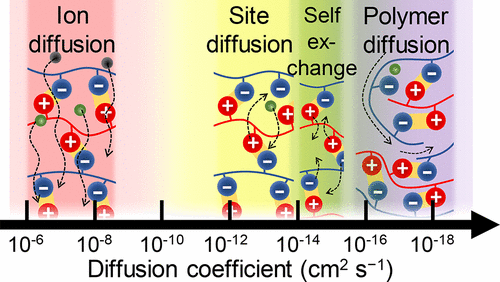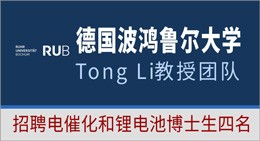当前位置:
X-MOL 学术
›
J. Am. Chem. Soc.
›
论文详情
Our official English website, www.x-mol.net, welcomes your
feedback! (Note: you will need to create a separate account there.)
Diffusion of Sites versus Polymers in Polyelectrolyte Complexes and Multilayers
Journal of the American Chemical Society ( IF 14.4 ) Pub Date : 2017-10-05 , DOI: 10.1021/jacs.7b07905
Hadi M. Fares 1 , Joseph B. Schlenoff 1
Journal of the American Chemical Society ( IF 14.4 ) Pub Date : 2017-10-05 , DOI: 10.1021/jacs.7b07905
Hadi M. Fares 1 , Joseph B. Schlenoff 1
Affiliation

|
It has long been assumed that the spontaneous formation of materials such as complexes and multilayers from charged polymers depends on (inter)diffusion of these polyelectrolytes. Here, we separately examine the mass transport of polymer molecules and extrinsic sites-charged polyelectrolyte repeat units balanced by counterions-within thin films of polyelectrolyte complex, PEC, using sensitive isotopic labeling techniques. The apparent diffusion coefficients of these sites within PEC films of poly(diallyldimethylammonium), PDADMA, and poly(styrenesulfonate), PSS, are at least 2 orders of magnitude faster than the diffusion of polyelectrolytes themselves. This is because site diffusion requires only local rearrangements of polyelectrolyte repeat units, placing far fewer kinetic limitations on the assembly of polyelectrolyte complexes in all of their forms. Site diffusion strongly depends on the salt concentration (ionic strength) of the environment, and diffusion of PDADMA sites is faster than that of PSS sites, accounting for the asymmetric nature of multilayer growth. Site diffusion is responsible for multilayer growth in the linear and into the exponential regimes, which explains how PDADMA can mysteriously "pass through" layers of PSS. Using quantitative relationships between site diffusion coefficient and salt concentration, conditions were identified that allowed the diffusion length to always exceed the film thickness, leading to full exponential growth over 3 orders of magnitude thickness. Both site and polymer diffusion were independent of molecular weight, suggesting that ion pairing density is a limiting factor. Polyelectrolyte complexes are examples of a broader class of dynamic bulk polymeric materials that (self-) assemble via the transport of cross-links or defects rather than actual molecules.
中文翻译:

聚电解质复合物和多层中位点与聚合物的扩散
长期以来,人们一直认为带电聚合物自发形成复合物和多层材料取决于这些聚电解质的(相互)扩散。在这里,我们使用敏感的同位素标记技术分别检查了聚合物分子和外在位点带电的聚电解质重复单元的质量传输,该单元由反离子平衡,聚电解质复合物 PEC 的薄膜内。在聚(二烯丙基二甲基铵)、PDADMA 和聚(苯乙烯磺酸盐)、PSS 的 PEC 膜中,这些位点的表观扩散系数比聚电解质本身的扩散快至少 2 个数量级。这是因为位点扩散只需要聚电解质重复单元的局部重排,对所有形式的聚电解质复合物的组装施加的动力学限制要少得多。位点扩散强烈依赖于环境的盐浓度(离子强度),PDADMA 位点的扩散速度比 PSS 位点快,这是多层生长的不对称性的原因。位点扩散负责线性和指数体系中的多层增长,这解释了 PDADMA 如何神秘地“穿过”PSS 层。使用位点扩散系数和盐浓度之间的定量关系,确定了允许扩散长度始终超过膜厚度的条件,导致超过 3 个数量级厚度的完全指数增长。位点和聚合物扩散均与分子量无关,表明离子对密度是一个限制因素。聚电解质复合物是更广泛的动态本体聚合物材料的例子,它们通过交联或缺陷而不是实际分子的传输(自)组装。
更新日期:2017-10-05
中文翻译:

聚电解质复合物和多层中位点与聚合物的扩散
长期以来,人们一直认为带电聚合物自发形成复合物和多层材料取决于这些聚电解质的(相互)扩散。在这里,我们使用敏感的同位素标记技术分别检查了聚合物分子和外在位点带电的聚电解质重复单元的质量传输,该单元由反离子平衡,聚电解质复合物 PEC 的薄膜内。在聚(二烯丙基二甲基铵)、PDADMA 和聚(苯乙烯磺酸盐)、PSS 的 PEC 膜中,这些位点的表观扩散系数比聚电解质本身的扩散快至少 2 个数量级。这是因为位点扩散只需要聚电解质重复单元的局部重排,对所有形式的聚电解质复合物的组装施加的动力学限制要少得多。位点扩散强烈依赖于环境的盐浓度(离子强度),PDADMA 位点的扩散速度比 PSS 位点快,这是多层生长的不对称性的原因。位点扩散负责线性和指数体系中的多层增长,这解释了 PDADMA 如何神秘地“穿过”PSS 层。使用位点扩散系数和盐浓度之间的定量关系,确定了允许扩散长度始终超过膜厚度的条件,导致超过 3 个数量级厚度的完全指数增长。位点和聚合物扩散均与分子量无关,表明离子对密度是一个限制因素。聚电解质复合物是更广泛的动态本体聚合物材料的例子,它们通过交联或缺陷而不是实际分子的传输(自)组装。







































 京公网安备 11010802027423号
京公网安备 11010802027423号